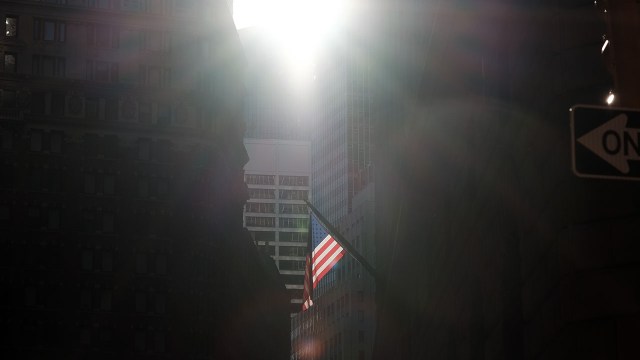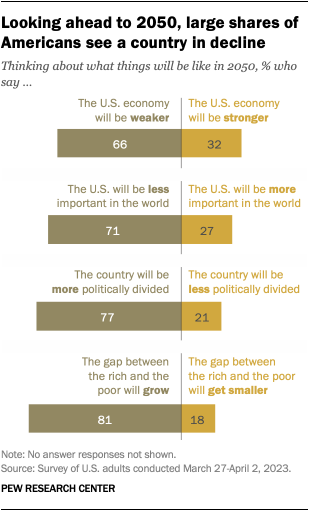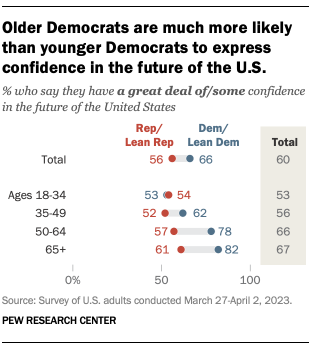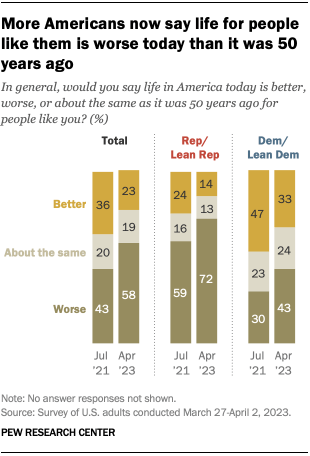
Americans are in a negative mood about the current state of the country, with large majorities expressing dissatisfaction with the economy and overall national conditions. And when they look toward the not-too-distant future, they see a country that in many respects will be worse than it is today, according to a new Pew Research Center survey.
Pew Research Center conducted this study to learn about Americans’ views of the country’s past and future. For this analysis, we surveyed 5,079 U.S. adults from March 27 to April 2, 2023. Everyone who took part in this survey is a member of the Center’s American Trends Panel (ATP), an online survey panel that is recruited through national, random sampling of residential addresses. This way nearly all U.S. adults have a chance of selection. The survey is weighted to be representative of the U.S. adult population by gender, race, ethnicity, partisan affiliation, education and other categories. Read more about the ATP’s methodology.
Here are the questions used for this analysis, along with responses, and its methodology.

Sizable majorities of U.S. adults say that in 2050 – just over 25 years away – the U.S. economy will be weaker, the United States will be less important in the world, political divisions will be wider and there will be a larger gap between the rich and the poor. Far fewer adults predict positive developments in each of these areas.
And when Americans reflect on the country’s past, the present looks worse by comparison. Around six-in-ten (58%) say that life for people like them is worse today than it was 50 years ago, according to the survey, which was conducted from March 27 to April 2.
Despite these negative attitudes, a majority of Americans say they generally have at least some confidence in the future of the U.S. But far fewer have quite a lot of confidence, and the share of Americans who express confidence in the country’s future has declined over the past year.
Views of specific problems have also become more negative over the past five years. For each of the four items included in the new survey, Americans today are about 10 percentage points more likely to offer a negative prediction than they were when asked to think about the year 2050 in a separate survey conducted by the Center in 2018. For example, 77% of Americans now expect the nation to be more politically divided in 2050 – up from 65% who made that prediction five years ago.
While majorities in both parties make negative predictions for the country’s future across all four items in the survey, Republicans and Republican-leaning independents are somewhat more likely than Democrats and Democratic leaners to have pessimistic views. In 2018, midway through Donald Trump’s term as president, Democrats’ predictions were more negative than Republicans’ on three of the four areas.
White adults are particularly likely to foresee a diminished U.S. in 2050. For example, 69% of White adults anticipate a weaker U.S. economy in 2050, compared with smaller shares of Hispanic (60%), Black (58%) and Asian (55%) adults. There are only modest age differences on each of the four items.
Americans’ negative views of the nation’s future are influenced by their bleak assessments of current conditions. Only 19% of Americans say they are satisfied with the way things are going in the country, while 80% are dissatisfied. Ratings of the economy remain largely negative, and an increasing share of the public expects economic conditions to worsen over the next year.
Compared with a year ago, less confidence in the future of the U.S.
When it comes to general views of the country’s future, six-in-ten U.S. adults currently say they have at least some confidence in the future of the United States, including 12% who have quite a lot of confidence. A third express very little confidence in the country’s future, while just 6% say they have no confidence at all.

Confidence in the future of the country has declined over the past year. In May 2022, 68% said they had at least some confidence in the country’s future, 8 points higher than the share who say this today. The share expressing at least some confidence in the future of the U.S. changed only modestly between August 2020 and May 2022.
As has been the case throughout Joe Biden’s presidency, Democrats and Democratic-leaning independents are more likely than Republicans and Republican leaners to express confidence in the country’s future. About two-thirds of Democrats (66%) have at least some confidence, compared with 56% of Republicans. In 2020, when Trump was president, larger shares of Republicans than Democrats expressed some or quite a lot of confidence in the country’s future.
Both Democrats and Republicans are less likely to express at least some confidence in the country’s future than they were a year ago. The share of Democrats saying this has dropped 8 percentage points, while the share of Republicans has dropped 6 points over this period. Overall, Democrats’ confidence in the future of the country has dropped 18 points since the early months of the Biden administration (84% of Democrats said they had at least some confidence in April 2021).
Older adults are more likely than younger adults to express a great deal of or some confidence in the future of the country. Two-thirds of those ages 50 and older have confidence in the future of the U.S., compared with a smaller majority of those 35 to 49 (56%) and 53% of those 18 to 34.

Differences between older and younger Democrats account for most of this age gap. A sizable majority of Democrats 50 and older (80%) have at least some confidence in the country’s future. That compares with 62% of Democrats ages 35 to 49 and 53% of those 18 to 34.
Among Republicans, by contrast, there are only modest differences on this question across age groups.
In both parties, adults with more formal education and those living in higher-income households are more likely to express a great deal of confidence or some confidence in the country’s future than those with less education and those in lower-income households.
College graduates are more likely than those without a college degree to say they have at least some confidence in the country’s future (69% vs. 56%). And three-quarters of adults living in upper-income households say this, compared with 60% of those in middle-income households and 53% of adults in lower-income households.
Americans’ views of life today versus 50 years ago
In contrast with their negative predictions for the country’s future, large shares of adults view the past in a more positive light than the present day. Around six-in-ten (58%) say that life in America is worse today than it was 50 years ago for people like them. Only about a quarter (23%) say life today is better, while 19% say it is about the same.

The share of Americans who say life today is worse than in the past is up 15 percentage points since the summer of 2021. The share who say life is better has decreased by a similar margin.
Republicans and Democrats alike are now more likely than in 2021 to say that life is worse for people like them, though this view continues to be more prevalent among Republicans than Democrats. Roughly seven-in-ten Republicans (72%) say that life is worse today, up from 59% who said this in 2021. Among Democrats, 43% now say this, up from 30% two years ago.
White adults are far more likely to say life today is worse for people like them than to say it is better (63% vs. 20%), as are Hispanic adults (53% vs. 26%). Attitudes are more divided among Asian adults (48% worse, 38% better) and Black adults (41% worse, 33% better).
While both older adults and younger adults are much more likely to say that life today is worse for people like them than to say life is better, there is a sizable age gap on this question. Adults 50 and older are 46 points more likely to say that life is worse today for people like them than they are to say that life is better (65% vs. 19%). Adults ages 18 to 49, by comparison, are 24 points more likely to say life today is worse (51% vs. 27%).
Note: Here are the questions used for this analysis, along with responses, and its methodology.